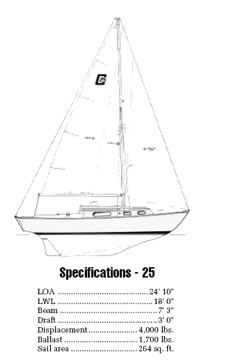
Cape Dory Yachts was, until its demise some years ago, one of the more conservative firms in the boatbuilding industry. With the exception of a brief fling with modern cruiser-racers— the Intrepid series—the company’s stock in trade since the late 1960s was traditional, full keel auxiliaries and sailboats, most from the design board of Carl Alberg, the octogenarian dean of American designers. It is ironic that a man who began his designing career drawing schooners and Universal Rule racing sloops in the office of John Alden should find his greatest popularity designing production fiberglass boats 60 years later.
Since he picked up the tooling for the well known 18′ 6″ Typhoon in 1969, Cape Dory owner Andrew Vavolotis showed an almost unswerving loyalty to the long keel with attached rudder, and to designs by Alberg. The Cape Dory 25 is one of the few designs not created by Alberg.
Credit for the basic design of the Cape Dory goes to George Stadel. The boat was originally built by Allied as the Greenwich 24. Vavolotis purchased the tooling during one of Allied’s frequent business disasters, redesigned the boat to suit his own ideas, and put the Cape Dory 25 into production in 1973. Hundreds of 25s were built, and the boat has rightly been termed a modern classic.
In the fall of 1981, Cape Dory introduced a new 25 footer, the 25D. “D” is for diesel, but there’s much more difference between the two boats than just the powerplant. Although a certain amount of confusion has existed about the two boats, the only thing that the 25 and the 25D have in common is overall length. The 25D was an entirely different boat: wider, heavier, deeper, with inboard engine, a dramatically different interior, and a new price tag 50% higher than that of the 25.
In a time when retrenchment was the watchword in the boatbuilding industry, Vavolotis had a Cheshire cat grin on his face when he said, “We’ve found our niche in the industry.”
For a number of years, that niche was narrow indeed. While racer-cruisers proliferated in the 1970’s, while the fat fin-keeler with the high aspect ratio rig became the industry vogue, Cape Dory continued to espouse long keels with attached rudders, relatively narrow beam, attractive sheer lines, moderate freeboard, and substantial overhangs— ”old fashioned” boats.
While there are a number of companies that offer a few traditional, heavy displacement boats, no other builder can claim a full line of ultraconservative designs. It might seem that Cape Dory created so many models that their prime competition was between boats in their own line, but apparently there was enough product differentiation to support several different models between 25′ and 30′.
Cape Dory customer loyalty is tremendous. Probably more owners trade up through the line than change builders when the time comes to upgrade, The cynic might say that it’s because no other builder caters exclusively to buyers of “traditional” boats. In fact, a large percentage of the product loyalty is generated by consistently good quality, high resale value.
Cape Dory boats are not for everyone, By any standard, both the 25 and the 25D are heavy displacement boats.
Interior volume of both boats is substantially less than that of “modern” 25-footers due to their relatively narrow beam and short waterline. By way of comparison, the Ericson 25 is almost three feet longer on the waterline and over a foot wider than the Cape Dory 25D, with almost identical displacement, ballast, sail area, and price.
The Cape Dory 25 is really a daysailing and weekending boat. Although the boat has berths for 4, accommodations are cramped and creature comforts minimal.
The 25D is a very different concept. She is a miniature cruising yacht. Inevitably she will be compared to that star of an earlier generation of pocket cruisers, the Laurent Giles designed Vertue.
Construction
Construction of all boats in the Cape Dory line is similar. Hulls are moderately heavy solid glass layups of mat and roving. Ballast in all cases is a lead casting. The casting is carried in a hollow keel molding, with voids between the casting and the molded shell filled with polyester slurry. The casting is heavily glassed over on the inside of the hull. While the workmanship and materials used in these ballast installations are excellent, we prefer an external, bolted-on lead casting for its shock absorbing qualities.
Decks and cabin tops are cored with end grain balsa. This results in a firm, stiff surface with good sound-absorbing and insulation properties. Gelcoat quality of the 25 and 25D is excellent. Light roving print through is evident, but there are neither external hard spots nor evidence of distortion of the hull from the attachment of the deck.
Cape Dory uses a wide internal flange for attachment of the deck molding. The deck is joined to the hull using a semi-rigid polyester compound. This joint is incidentally reinforced by the screws which attach the toe rail, by the through bolts of the pulpits and lifeline stanchions, by the chainplate bolts, and by deck hardware bolts. Our belt and suspenders approach to construction would prefer through bolting of the joint at close intervals in addition to the chemical bond and random fastening.
Cape Dory’s chainplate installations merit special comment. On the 25D, shrouds are attached to cast bronze lugs which rest on the deck over the hull/ deck flange. Each of these lugs is bolted through the flange with two 3/8″ diameter stainless steel machine screws. On the underside of the hull flange, a heavy aluminum plate is glassed in place using unidirectional roving, which also extends down the inside of the hull.
This is an immensely strong installation for a boat of 5,000 pounds displacement. The chainplates are less prone to leakage than conventional flat bar stock plates bolted to bulkheads.
The only disadvantage of this system is that it locates the chainplates at the outboard edge of the deck. This gives the shrouds a wide base for supporting the mast, but interferes with close sheeting of overlapping headsails.
All Cape Dory rudders are hung from the back of the keel. The primary advantages of this type of rudder are strength—a fairly important consideration for the cruising yacht—and relative invulnerability to damage.
The only real drawback to Cape Dory’s rudder installation is that dropping the rudder for repair is fairly complex. The cast bronze gudgeon/heel fitting must be removed by grinding off the heads of its fastenings at the base of the keel. Then the rudder and stock are pulled out from below, necessitating either a deep hole under the boat or lifting the boat with a crane or Travelift while the rudder is being removed.
All deck hardware is through bolted using stainless steel bolts and aluminum backing plates. The forestay fittings on both the 25 and 25D are heavy bronze castings, as are cleats, winch islands, and portlights.
We have one reservation about Cape Dory’s hardware installations. The mixture of bronze castings, stainless bolts, and aluminum backing plates strikes us as less than ideal. While the deck hardware is not immersed in an electrolyte, there is a difference in voltage potential between the aluminum backing plate and the manganese bronze casting. The type304 austenitic stainless fastenings are relatively inert, but they do join very dissimilar metals, Below the waterline, Cape Dory uses silicon bronze fastenings in their bronze castings.
Cape Dory had its own hardware division—Spartan Marine Products—which produced a broad range of deck and hull hardware, as well as assembling all spars for Cape Dory. Spartan was founded in 1975 when it became increasingly difficult to get cast bronze hardware to complement Cape Dory’s traditional designs.
We have previously been critical of Spartan for the poor finish quality of their products. While their castings were excellent, the hardware was only availablein what is traditionally known as “burnished” finish—ground and tumble polished to remove roughness from the casting process, but not mirror finished. Later on Spartan offered most of their hardware in burnished, polished, or chrome finish. Polished hardware truly accents the classic yacht. In acknowledgment of that fact, Cape Dory made polished hardware standard on their flagship 36-footer.
Spartan seacocks are used on all through hull fittings below the water on the 25D, including head intake and discharge, cockpit scuppers, engine cooling water intake, and galley sink drain. Engine ex- haust and bilge pump discharge exit through the transom, and have no provision for shutoff. On the 25, bronze ball valves are used in place of seacocks.
The 25D uses a full molded hull liner which incorporates all the major furniture components. Interior trim and systems are installed in the liner before it is fiberglassed into the hull. The liner itself is a heavy solid layup almost as thick as the hull. The only disadvantage to the full hull liner is limited access to the inner surface of the hull in the event of catastrophic damage. Bilge access in the 25D, for example, is only through a small trap in the main cabin sole. Repairs requiring access to the inside of the hull skin will require major surgery.
The general standard of workmanship in Cape Dory boats is very good, and both the 25 and 25D sustain this standard. The 25D, with its emphasis on fairly serious cruising, is a far more complex boat than the 25 in both systems and construction. The 25D is probably one of the strongest boats of her size on the market.
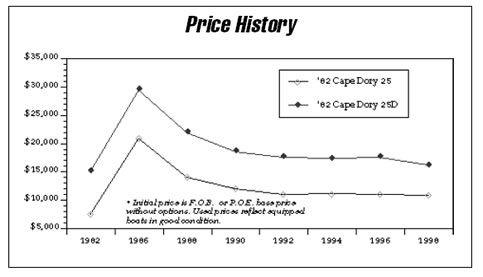
Handling Under Sail
While both the 25 and 25D are cruising boats, neither should be a dog under sail. Owners of the 25 report average speed compared to other boats that size.
Thanks to a ballast/displacement ratio of almost 43%, the 25 is a stiff boat despite her narrow beam and slack bilges. Stability is enhanced by a short, low aspect ratio rig. Owners report that a 150% genoa is a must to keep the 25 moving in light air.
The 25D may actually have better performance potential than the 25. The 25D’s rig is substantially more modern in design, with a mast 4 1/2′ taller than that of the 25, a J measurement over a foot longer, and a higher aspect ratio mainsail. The extra 6″ of draft, 9″ of beam, hard bilges, and 350 pounds of additional ballast should make her quite stiff.
The 25D came with a recessed inboard jib track as well as the rail-mounted genoa track common to both boats. Both have full width mainsheet travelers mounted at the aft end of the cockpit.
Cape Dory boats 30′ and under came with factory supplied sails built by several different lofts. OEM sails rarely come up to the quality of sails custom built for a particular boat sailed in a specific locale. Though the stock sails may be adequate while you’re learning to sail the boat, they probably won’t be when you become interested enough in good performance to appreciate the difference between a mediocre suit of sails and a really good suit.
With either the 25 or 25D, the first sail you’ll want to add to the boat is a 150% genoa, no matter where you sail, A lot of sail area can compensate for a lot of wetted surface when sailing in light air.
Both the 25 and 25D have deck-stepped masts. In the 25, most of the mast compression is carried by the main cabin bulkhead. In the 25D, an aluminum compression column directly under the mast transfers the rig compression to the keel. Cape Dory’s support systems for deck-stepped masts are among the best we’ve seen.
The mast on the 25D was originally designed to step through to the keel. The sales department feared that a large mast tube in the main cabin might turn off potential buyers, so the mast tubes were shortened, and a complex, more expensive deck stepping arrangement was incorporated. This isn’t the first time in the industry the sales department has overridden the engineering department, and it won’t be the last.
The main boom of the 25 is equipped with roller reefing, a method of sail reduction that has, thankfully, just about vanished. It is almost impossible to get good sail shape going to weather with a roller reefed main, and you really haven’t lived until you’ve tried to crank in half a dozen rolls in a rising gale offshore while the reefing gear binds and the sail luff grinds itself to shreds in the reefing gear. Jiffy reefing, which is standard on the 25D, is preferable to roller reefing in almost every way.
In performance, neither the 25 nor the 25D will be mistaken for a racer-cruiser. Nevertheless, the owner concerned about improving performance can make real improvements by fairing in through hull fittings, wet sanding the bottom paint, and buying higher performance sails.
Handling Under Power
A major difference between the 25 and 25D is their mechanical propulsion systems. The Cape Dory 25 has an outboard well at the aft end of the cockpit, while the 25D has inboard diesel power.
The outboard engine installation of the 25 is less than 100% successful, according to owners responding to our survey. The cover to the engine compartment must be kept open to provide adequate air for the outboard engine when running under power. The engine well resonates loudly, making the 25 noisy under power.
The 25 will accommodate engines up to 15 horsepower, but the most commonly used engines are the Johnson and Evinrude 9.9 horsepower units, which provide more than adequate power for the boat.
The engine’s location aft of the rudder means that there is no prop wash effect on the rudder to aid low speed maneuvering. Coupled with the 25’s long keel, this means that the boat will be slower to respond under power than a modern fin keeler of similar displacement.
Handling the 25 in reverse is a problem, according to owners. A large percentage report in our survey that the boat “doesn’t maneuver in reverse worth a damn.”
The 25D has a conventional inboard engine installation, using a raw-water-cooled Yanmar 1QM 7 ½ horsepower diesel. At 154 pounds, this is one of the lightest small diesels available. The 13 gallon fuel tank, mounted under the cockpit, should give the 25D over 50 hours of operating time under power, or a range of about 250 miles.
A two-bladed solid bronze prop is standard, tucked in an aperture at the aft end of the keel. The aperture extends into the rudder, which will cause some cross ventilation and slight loss of rudder efficiency under sail. The 2.62:1 reduction gear should allow the little engine to achieve full power in driving the 25D.
The engine installation is excellent, and meets ABYC standards for the installation of gasoline engines, as well as the far simpler standards for diesels. A lift-out plastic storage bin in the top of the engine box removes for routine service of belts and filters, as well as for checking oil. The compartment is not soundproofed.
More thorough access to the engine can be gained by removing the companionway ladder and unscrewing the plywood front panel of the engine box.
Deck Layout
The 25 and 25D share a simple, uncluttered deck layout, although the 25D has some features lacking in the 25. The 25D has a large foredeck anchor well capable of holding the normal working ground tackle for the boat. The 25D’s stemhead casting incorporates an anchor roller. We would add a large eyebolt to the anchor well to secure the bitter end of the anchor rode.
While the 25 has a single centerline foredeck cleat, the 25D has twin cleats outboard of the well.
Bowlines should be secured to the cleat on the opposite side from the bow chock to avoid blocking access to the well.
You can have any hull and deck color in a Cape Dory as long as it’s Cape Dory off-white and tan. The white of the cabin house is a warm brownish white, and will not unduly reflect light on bright days. Tan nonskid areas avoid the desolate appearance of white on white found on some boats.
The 25 and 25D both have teak toerails and rubbing strake, teak cabintop handrails, and teak cockpit coamings. We strongly recommend that these be kept in good shape by the application of a teak dressing. Despite the fact that teak is reasonably forgiving of neglect, it does require some maintenance to avoid warping and checking.
Bow pulpit, stern pulpit, and single lifelines were standard on the 25D. A bow pulpit was standard on the 25, but lifelines and stern rail were optional. The 25D incorporates Aqua Signal international style running lights in the pulpits.
Cockpits of both boats are large and reasonably comfortable, although the coaming sides are vertical rather than being slanted at a good angle for really comfortable seating. Older models of the 25 had a low cockpit sill, with the lowest companionway drop board six inches above the cockpit sole. Newer models have a substantial bridgedeck.
Both the 25 and 25D have large cockpit scuppers leading to through hull fittings with shutoff valves. The scuppers are properly located at the forward end of the cockpit, which prevents flooding by the quarter wave.
There are large lockers under both cockpit seats on the 25. The 25D has a shallow locker to starboard over the quarterberth and a deep locker to port. Access to the stuffing box on the 25D is through the port locker.
The tiller on both boats takes up a lot of the cockpit whether sailing or at anchor. A few 25Ds have been delivered with pedestal steering, which seems a little presumptuous on a boat this size, but does free up the cockpit for seating.
With a good solid bridgedeck, big scuppers, and a companionway that is almost parallel sided, the 25D has a cockpit suited for offshore use, although its volume is at the upper limit for a small boat. The use of plywood drop boards is rather disappointing on a boat of this quality, A properly made solid board is as warpfree as plywood, and certainly looks better.
Belowdecks
The most obvious difference in the two boats is belowdecks. The 25 is a minimal short term cruiser for two adults and two children, while the 25D has a genuine cruising interior for a couple.
The 25 has what could best be described as stooping headroom. The forward cabin has a sharply tapered vee-berth that is too small for two normal size adults. Immediately aft is a cramped toilet compartment, divided from the vee-berths by a curtain and from the main cabin by folding doors.
The main cabin settees double as berths. Actually, they are berths doubling as settees, as there are no backrests for comfortable sitting. Because the galley sink hangs over the foot of the port settee, owners report that as a berth it is only comfortable for a fairly short person.
The galley consists of platforms port and starboard at the foot of the settees. The starboard platform can hold a two burner stove, which is optional, or can be used for navigating. The port counter contains the aforementioned sink. There is a small icebox under the companionway step.
Stepping from the 25 to the 25D is a confusing experience. On a marginally larger hull, Cape Dory has produced a boat with an interior that a couple could find comfortable for fairly extended cruising. Without substantially raising either freeboard or cabin trunk, the 25D has been provided honest headroom of about 5′ 11″.
One way this has been accomplished has been by dropping the cabin sole well into the bilge. Headroom is gained at the cost of cabin sole space. In this case, it’s a fair tradeoff. The only real impingement into the headroom is the teak finishing piece for the overhead companionway hatch, which extends down a full two inches. Many people will find this a real headcracker.
The interior of the 25D is unusual in that a forward cabin has been eliminated, and a huge head, which can be fitted with a shower, installed in the space that would otherwise be a cramped berth.
The head compartment has headroom of 5′ 9″, two hanging lockers, a small sink, and two solid towel rack/grab rails. Anyone who’s spent any time in the head in rough weather will appreciate the grab rails.
Although there is little storage space in the head for sheets, towels, medicine, or other small items, there are two large blank bulkheads crying out for the handy boat owner to install cabinets or shelves.
The shower, if installed, drains directly into the bilge, an arrangement that leaves something to be desired, A Bomar hatch over the head provides good ventilation, as do the two opening ports in the head compartment.
Attractive is an overused word, but it is truly descriptive of the main cabin. The hull outboard of the settee is lined with ash, a welcome change from the teak used by most builders.
Main cabin settees extend through the head bulkhead into alcoves that form the dresser surfaces in the head. These alcoves are handy for storing bedding or other loose items under sail.
Cape Dory gets an A+ for main cabin settee comfort in the 25D. The settee backs are nicely padded, properly angled, and the settee tops have been reduced to the proper width for comfortable seating. Thank God someone has discovered that most people don’t sit bolt upright when they can avoid it. For sleeping, the backs fold up on hinges and latch out of the way.
The starboard settee extends, with a little maneuvering, to form a double, giving the 25D nominal accommodations for four adults. We doubt if two couples would really want to share one cabin on a 25 footer for any period of time.
A 20 gallon polyethylene water tank is mounted under the starboard quarterberth—undeniably the best berth in the boat, but one that is likely to be used more for storage than for sleeping if the boat is cruised by a couple, Ironically, this water capacity is four gallons less than that of the Cape Dory 25.
With a little imagination, the galley of the 25D could probably be made far more serviceable for the serious cruiser. There is little storage space for any quantity of food, although there is enough room under the bridgedeck and outboard of the stove to create much more.
The sink is tucked away under the bridgedeck, and truly is almost impossible to use. To reach the fresh water pump, being a contortionist would be a virtue. Washing dishes would be an acrobatic exercise.
The galley stove is a two burner recessed Kenyon alcohol model with integral tank, a type of stove about which we have grave reservations. Alcohol is a poor cooking fuel for a serious cruising boat, being expensive, bulky, and inefficient.
Cross ventilation of the main cabin is excellent, with four opening bronze ports. Cowl vents in dorade boxes should be fitted at the aft end of the main cabin for foul weather and offshore ventilation.
With the exception of the galley, the interior of the Cape Dory 25D is one of the most functional we have seen for a small cruising boat.
Putting the head in the forepeak and eliminating the cramped vee-berth are excellent ideas in a boat of this size. The lack of privacy in the head, a major complaint in small cruising boats, is a problem Cape Dory has solved in one bold stroke.
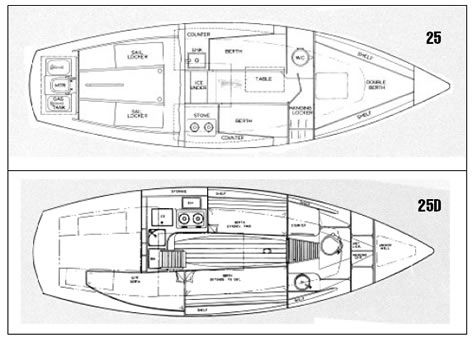
Conclusions
For two boats of similar size and type, the Cape Dory 25 and 25D are radically different from each other. The 25 is a daysailer and weekender, with cramped accommodations. The 25D has the potential to be a comfortable long-term cruiser for a couple, with a roomy interior whose only real flaw is a mediocre galley arrangement.
Construction of both boats is solid, and they are well finished, although not perfectly so. Finish detail on later boats is substantially better than on Cape Dory boats of the late ’70s.
The 25D is tough enough to be a serious cruising boat, We would not be surprised to hear that someone sails one across the Atlantic, although ocean voyaging in so small a boat is not our personal cup of tea.
Cape Dory boats are for traditionalists. In a time when traditionalism and conservatism seem to be growing in popularity, the appeal of boats such as those produced by Cape Dory is assured.


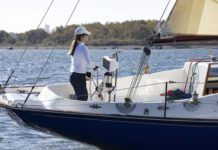


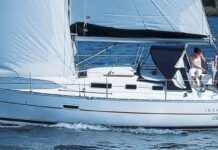
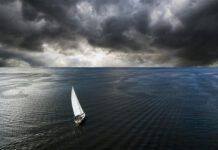



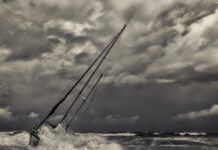
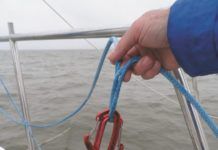


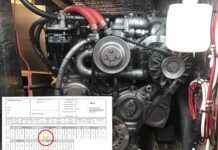


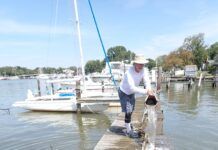













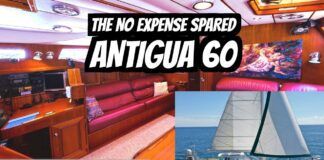



Excellent write up